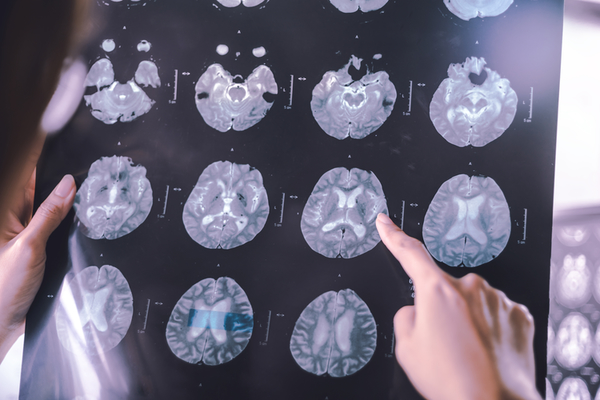
Dementia is a medical condition that causes a progressive decline in cognitive function. This includes memory, language, executive and visuospatial function as well as personality and behavior. It can lead to loss of ability to perform basic and instrumental daily activities. Alzheimer's disease (AD), which accounts for as much as 80% of all dementia diagnoses, is the most common form of dementia. Despite a decrease in stroke and cardiovascular deaths in the United States, AD-related deaths are increasing. They have increased by 89% between 2000 & 2014. The direct and indirect healthcare costs associated with AD are approximately $500 billion annually. A definitive diagnosis of AD is possible only after a post-mortem examination of brain tissue. This can be done using cerebrospinal fluid and positron emission tomography (PET), biomarkers, as well as a number of new clinical criteria. There are currently two options for treating AD: memantine for those with mild-to-severe AD and cholinesterase inhibitors to treat patients at any stage. When prescribed at the right time, these medications can improve the quality of life for the patient and the caregiver. However, they don't alter the course or rate of decline. Clinical research is moving towards more definitive treatments for AD's hallmark pathology. This will hopefully reduce the progression of cognitive decline that is associated with this disease (Figure 1). This review will summarize current and future treatments for AD patients.
Memory and Alzheimer's disease
Memory loss (M) over time (t = months to years). Normal aging slows down memory (1). Alzheimer's disease causes a more rapid decline in cognitive ability, which often starts earlier in life (2). Current treatments improve cognition but do not alter the rate at which AD is developing (3). Novel therapies are expected to reduce the rate of decline (4).
Go to:
Evaluation
The original 1984 diagnostic criteria were used by the National Institute on Aging and Alzheimer's Association. In 2011, the NIA-AA revised the clinical criteria to diagnose mild cognitive impairment (MCI), as well as the various stages of AD. To aid in the identification of AD from other forms, as well as the diagnosis of MCI due to AD, the use of supportive biomarker evidence (imagings, serum, and CSF of AD pathology) was added. The Diagnostic and Statistical Manual of Mental Disorders Fifth Edition (DSM-5), reclassified delirium and dementia as well as amnestic and other geriatric cognitive conditions into the larger neurocognitive disorders. This was done to make it easier to distinguish between neurodegenerative diseases such as AD, dementia, and dementia with Lewy bodies and frontotemporal dementia. It also included both major neurocognitive conditions (equivalents to dementia) as well as mild neurocognitive disorders (equivalents to MCI). The newer criteria also allow the use of future and current biomarkers to diagnose degenerative brain diseases.
Recent developments in non-invasive diagnostic imaging have led to a test that improves the accuracy of diagnosing AD 10. Patients are given a radiolabeled tracer agent and undergo a PET scan. This scan detects the formation of amyloid-b (Ab peptides) plaques in their brains. This method was used by clinicians to diagnose the disease with a 96% sensitivity level and 100% specificity in 2012. The same test was used to diagnose milder diseases over the next year. Nearly a decade ago, researchers from the University of Pittsburgh developed the first tracer. The US Food and Drug Administration approved florbetapir's use for the detection of AD pathology. Florbetaben, flutemetamol, and florbetapir are now among the amyloid-specific PET drugs. They all have similar profiles 12, 13. Amyloid PET imaging is not covered by most insurance companies, so its use in practice is limited. The majority of patients who have amyloid PET scanning done are part of clinical trials.
An examination of the CSF for Ab42 hyperphosphorylated Tau peptide (pau) and total tau protein is a less invasive but more expensive option. This method is less accurate (85-90%) and has more risks than a lumbar puncture. It can also take weeks to get results due to the lack of fluid analysis facilities. A head-to-head comparison did not show any difference in diagnostic accuracy between CSF Abs42:pau ratio and amyloid PET Imaging biomarkers. This suggests that the best test for each patient depends on availability, cost, and provider preference. Current developments show promise for less-invasive serum tests that can detect the number of proteins involved in AD. One test distinguished between normal cognition, MCI, and dementia due to AD in 2017 with a small group of patients having specificities of 84% & 88%, respectively. The serum microRNA profile screening, which has shown promise in smaller trials, is another blood test that proves to be valid and reproducible. The hope is that the simple blood test could help in diagnosing AD 18 with validation from larger-scale studies.
Go to:
Current treatment
There are currently only two types of pharmacologic treatment available for patients suffering from AD. Galantamine, rivastigmine, and donepezil are the recommended therapies for patients with mild, medium, or severe AD. Memantine is approved for patients with mild-to-severe AD (minimal mental state examination [MMSE] >15), who have difficulty paying attention or alertness. Patients who are looking for alternative therapies may consider nutraceutical Huperzine A. It has been shown to improve
Sources:
https://www.alz.org/alzheimers-dementia/difference-between-dementia-and-alzheimer-s
https://www.nia.nih.gov/health/what-alzheimers-disease

Leave Comment Below
0 Comment(s)